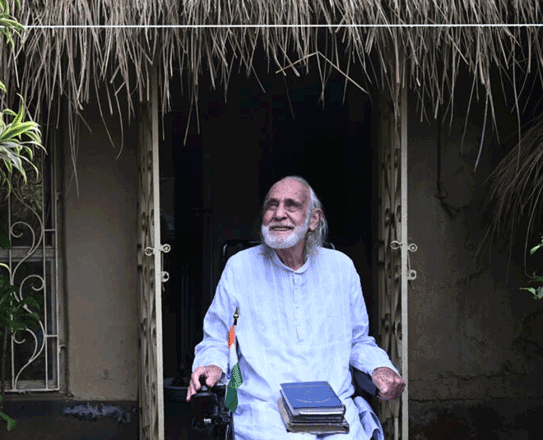You are here
The possibility of reinventing yourself
By Sally Bland - Jan 04,2015 - Last updated at Jan 04,2015
Shantaram
Gregory David Roberts
New York, St. Martin’s Press, 2003
Pp. 936
“Shantaram” is more than a novel. It is an invitation to share in an unparallelled human experience of adventure and soul-searching which is, in essence, a true story. As a young man in Australia, the author, Gregory David Roberts, resorted to heroin when his marriage fell apart, and then to armed robbery to sustain his addiction. Arrested and sentenced to 19 years in prison, he escaped, eventually arriving in Bombay, where he began a new life, assuming the name, Lin, and working first as a medic in a slum and then for a branch of the Bombay mafia.
The protagonist and narrator of the novel follows a similar trajectory, making it a type of autobiography. Reportedly, there has been debate as to whether all the particulars in the book are true or not, but this is beside the point. The impact of the story lies not so much in Lin’s adventures, though they are breathtaking, but in how he interprets the people and events with which he becomes involved. His experience in India and later when he follows a charismatic leader into the Afghanistan war of the 1980s, catalyse his search for himself and for meaning in life.
This is a novel that builds on contrasts and contradictions — the dazzling contrasts of India; the seemingly contradictory natures of people he meets, such as Khader Khan, the mafia boss who is simultaneously a devout Muslim and philosopher; and the tangled lives of other foreign fugitives, especially the mysterious Karla with whom Lin falls in love.
Not least are Lin’s inner conflicts, his contradictory self-images and the self-doubt with which he struggles. Roberts’ writing style is more than equal to all these contrasts as it ranges from exquisite descriptions of the beauty of India and the spirit of its people, to harsh, graphic, profane accounts of gang violence and war, as well as the cruelty of poverty, which also kills.
Almost the only main character who is free of contradictions is Prabaker, Lin’s self-appointed guide who pulls him out of the expatriate milieu for a tour of “the real India”, beginning with his own village. Here Lin stays six months, learning Marathi and local customs, acquiring the name Shantaram, which means “man of peace”, and beginning his journey of self-understanding.
The first night, the villagers fear that he will be lonely, so they gather around his sleeping place. At one point, Parabaker’s father stretches out his hand to rest on Lin’s shoulder. “It may sound strange… but until that very moment I’d had no real comprehension of the wrong I’d done, and the life I’d lost… [In prison] I was too busy being punished, and feeling punished, to put my heart around it… It was only there, in the village in India, on that first night, adrift on the raft of murmuring voices, and my eyes filled with stars; only then, when another man’s father reached out to comfort me… did I see and feel the torment of what I’d done, and what I’d become… and how lonely I was.” (p. 124)
The time Lin lived in the slum was even more life-changing. Having prior first-aid training and putting it to use when a fire hits the slum, he is accepted into the community and even revered by the slum dwellers. He takes it as a learning experience. While recording all the tragedies and extreme difficulties of their lives, he also focuses on their ability to find happiness in simple things, their inventiveness in resolving problems and conflicts, and most of all, their key to survival — love, love for each other, and the mutual support it generates.
Much that happens in the first two-thirds of the novel is not of Lin’s choosing. A combination of circumstances leads him to live in the slum; another combination, partly engineered by others and which he only understands in hindsight, lands him in prison in Bombay and then into working closely with the mafia. He leads a more comfortable life, but the new imprisonment, new torture, new fighting, new dangers — all of these cause him to keep reliving his past and question himself, and even threaten his sanity, but he rules out leaving Bombay. “The city had seduced me. I was in love with her. There was a part of me that she invented, and that only existed because I lived there…” (p. 459)
This book would be well worth reading if only for its fascinating inside view of the many faces of Bombay, but even more important is Lin’s interior landscape as we follow his quest to redefine himself and his values. You don’t feel you are reading a novel, but that you are living it. And you will never think exactly the same about the meaning of love, freedom, good and evil, forgiveness, human responsibility and redemption. “Shantaram” is available at Readers/Cozmo Centre.
Related Articles
Unlike the Hollywood sign — the almost 13.5-metre American landmark and cultural icon that is situated on Mount Lee in Los Angles, Californi
Lee Chong Wei has dominated the world rankings without ever capturing one of badminton’s biggest prizes and now the Malaysian’s hopes of a last shot at glory appear likely to have ended in an Oslo laboratory.
GOHALOPATA, India — Decades after inspiring a best-selling novel that brought readers into slums near Kolkata, 86-year-old ascetic Gaston Da


















